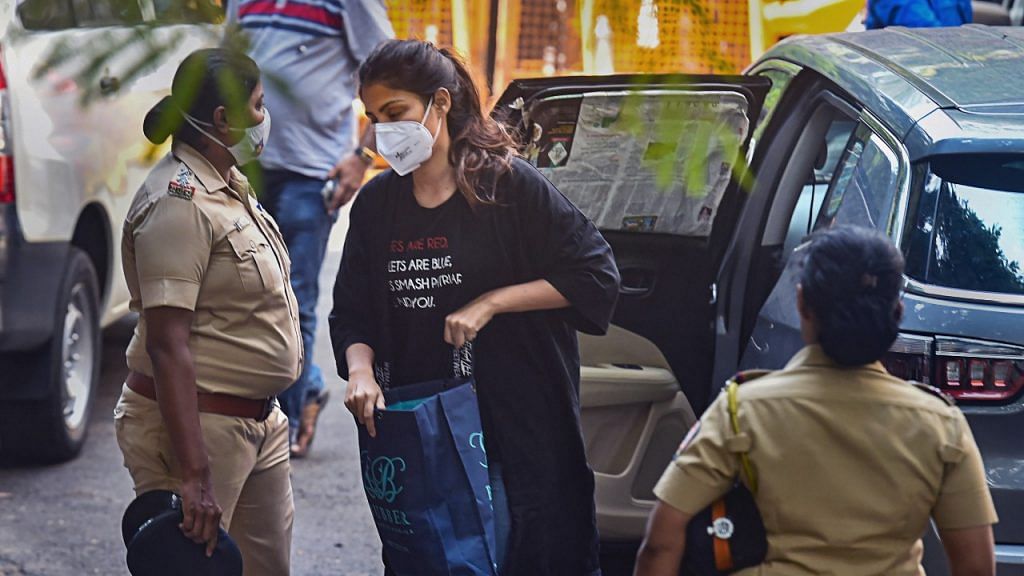In English Literature, we learn about a certain ‘type’ of female characters, known as the Gorgon-Medusa characters. They are women hated throughout the course of a novel or play for always living an unconventional life, never giving into diktats of men, and somehow offending anyone and everyone who comes their way. Spoiler alert: These women were always killed off, serving as a warning to readers that a woman should always ‘know her place’.
For the past few weeks, we have seen this literary principle play out in real life. In India, crimes against women have become the norm, but actor Rhea Chakraborty’s vilification in the Sushant Singh Rajput case was accompanied by a larger political play in the background. This was heightened by the fact that news channels were baying for her blood.
Her media trial has only reinforced the idea that women always have to be held to a higher standard in Indian society. The sheer number of aspersions made on Chakraborty, from her being a witch who allegedly practices black magic to a drug-peddler, highlights the ordeal women have to go through when embroiled in controversy.
Much has been written about how in Chakraborty’s case, news channels became judge, jury and verdict. Clearly every story needs a villain, and India loves making women the villain. Because our Raja betas do no wrong, and if they do, women obviously made them do it.
Also read: Dear viewer, you supported Rhea Chakraborty’s media trial. Republic TV, Times Now TRPs show
Not the first woman to suffer this fate
Rhea Chakraborty is not the only one who has been subjected to brutal public shaming and widespread condemnation.
Earlier this year, Kerala’s controversial airport gold scam was uncovered, and with it came another female ‘villain’ — Swapna Suresh. The former employee of the UAE consulate in the state’s capital, who is among the four accused booked by the National Investigation Agency (NIA) for smuggling 30 kg of gold, could have been criticised for a lot of things. But the attention she received was primarily based on two things: How promiscuous she is, and the way she looks.
Having been photographed with several prominent politicians, the regional Malayalam media implied that she was sleeping with all of them. She was also a divorcee, had straightened hair and wore makeup — the trifecta of the destructive modern woman who uses her sexuality to her own end.
This sort of flak was not extended to the main accused in the case, P.S. Srinath.
Everyone talks about how this country deifies women, but in reality, it is the men who are elevated to a sacred position. They become Laxmana, and the women in their lives are akin to Shurpanakha — depraved and demonic. In Chakraborty’s case, Sushant Singh Rajput has now occupied such an exalted status after his death, while she has become public enemy number one. Neither of them, mind you, had any say in this.
This has happened before. In 1990, just seven months after their wedding, veteran actor Rekha’s husband Mukesh Agarwal died by suicide, and he hung himself with her dupatta. Soon after, Rekha became the target of a widespread hate campaign, and was blamed for her husband’s death. Her character was maligned and she was called ‘The Black Widow’ and a witch.
But perhaps the worse example was the case of Uma Khurana, a government school teacher who was falsely accused of running a prostitution racket. She was mobbed, beaten, and stripped after such reports surfaced.
Also read: Indians find the perfect villain in Rhea Chakraborty. It says more about India than her
When women are reduced to tropes
All these instances are examples of how women get boxed and cramped into negative tropes — the witch, the slut, the homewrecker, the ‘druggie’, the murderer. Public shaming is a rather formidable phenomenon, and for women, it is steeped in misogyny.
This is why a significant section of social media got so triggered when just before Chakraborty was arrested Tuesday, she was photographed wearing a t-shirt with the ditty,“Roses are red, violets are blue, let’s smash patriarchy, me and you”. Oh thou patriarchy of feeble roots! Just a t-shirt was enough to rankle your followers to frothy hatred.
But this article would be incomplete without mentioning how women themselves have acted as foot soldiers in this system of misogyny. From news anchors such as Navika Kumar and Anjana Om Kashyap, to Right-wing individuals such as Shefali Vaidya and Priti Gandhi who is ironically part of the Bharatiya Janata Party’s Mahila Morcha. A fact to note is that all these women are privileged, upper-class and upper-caste women.
At this point, we cannot expect much from men in this country. They’re either shouting their lungs out at 9 pm, or shouting their lungs out in political rallies — no difference really.
But when women join in this vilification and public shaming, there is not much left to be said.
Views are personal.
